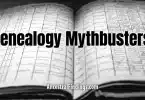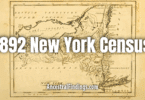Are you doing census research in your genealogy right now? You’ve probably already discovered that only heads of households were listed by name until the 1850 census. Many genealogists, particularly beginners, look at earlier censuses as mostly useless. Of course, the more experienced you become with genealogy, the more use you will get out of pre-1850 census records. These earlier census records can tell you how many people lived in a person’s household, what their genders and age ranges were, and whether there were any slaves in the household (including genders and age ranges). If you know nothing about the family, this information will give you clues to study in further research. If you know a little bit about the family, you can start to place the people you know into the appropriate households.
Still, the things you can do with most pre-1850 census records is limited. Things start to change for the better with the 1840 census, though. This is the first census that really provides a wide range of genealogically useful information beyond numbers, genders, and age ranges in a household. In fact, the 1840 census is a little known genealogical treasure, even though it still only lists the names of the heads of households. You can glean a lot of important information from this census that earlier ones don’t provide.
Here are the things the 1840 census includes that you won’t find in earlier census records:
- The name of the head of the household
- The address of the house (useful if you want to try to find it, or the land on which it was located)
- The number of free white males and free white females, divided into the following age groups: 0-5 years, 5-10 years, 10-15 years, 15-20 years, 20-30 years and every 10 years up to age 100, and ages 100 and older.
- The number of slaves in the household, divided into the same age groups and by gender
- The number of free black people in the household, divided into the same age groups and by gender
- The number of insane people in a household, by race
- The number of deaf, mute, and blind people in a household, by race
- The number of people actively attending school in each household
- Seven different occupations, and the number of people in the household employed in each of these occupations, if any
- The number of white people in a household over the age of 20 who could not read or write
- The number of Revolutionary War pensioners in the household
This is a lot of genealogically significant information, and you won’t find it in other census records, even after 1840. Much of the information included in the 1840 census is particular to that census alone. If you are looking for hidden information on your family before 1850, the 1840 census will provide you with a wealth of it.
While you won’t get names to go with this information, it tells you a lot about your family in 1840 and provides you with further avenues of research. Start searching this fascinating census today and see what informational treasures you discover.
1840 Census Index, U.S. Selected Counties (Free Lookups)






